
The very first FL9 built, Conrail 5000, is alive and well August 17, 1981, as it and sister 5057 lead Danbury, Connecticut to Grand Central Terminal local 1845 over the former New Haven main line at Cos Cob, Conn. Scott Hartley photograph


Zebra-stripped Conrail RDC 28 -- still lettered New Haven -- negotiates the interlocking at Devon, Connecticut, while running from Waterbury to Bridgeport under the sponsorship of Connecticut DOT in October 1976. Tom Nelligan photograph


Ex-Pennsylvania Railroad GG1, now Conrail No. 4800, Bicentennial-painted locomotive hauls a passenger train through Wildcat Tunnel, Maryland, in September 1976. F.H. Abendschein photograph


Conrail train 400, a Washington-Baltimore run funded by Maryland DOT, makes its afternoon stop at Bowie, Maryland, August 4, 1981. The equipment is leased NJ Transit Arrow II cars. Scott Hartley photograph


Conrail train No. 454, the 5:05 departure from Chicago bound for Valparaiso, Indiana, rolls past 21st Street in Chicago on April 8, 1977 -- the date which had originally been set for termination of the Conrail trains. Gary Dolzall photograph


Conrail "Valpo" or Chicago to Valparaiso, Indiana, commuter train No. 454 with Geeps 7508 and 7506 (Long hood forward!) on October 6, 1978. This was also supposed to be the last Conrail commuter run, but was delayed. Joe McMillan photograph


Conrail's Chicago commuter "dummy" trains, entangled in train-off efforts, still run. Since most P70 coaches there are out of service, on train has a mix of Amtrak and ex-Erie-Lackawanna cars and P70s, the other (above) ex-Chicago & North Western bilevels leased from Amtrak. Since Valparaiso, Indiana, has no turning facility, it's "pull-pull" with Amtrak F40 and CR Geep at the ends. J. David Ingles photograph


A train of classic heavyweight MUs rounds a curve at Summit, New Jersey, on Conrail's former Erie Lackawanna Hoboken-Dover electric line in June 1976. A trailer car is in the lead. Tom Nelligan photograph.


With the World Trade Center twin towers in the background, ex-New York Central, ex-Penn Central No. 4678 Class T-2a electric sits idle on the deadline in Amtrak's Sunnyside Yards in New York City on March 29, 1978. Stephen Williams photograph


The fireman aboard FL9 No. 5052 looks back for the conductor's highball as a Conrail-Metropolitan Transportation Authority commuter train takes on passengers at Mt. Kisco, New York, March 14, 1977. Scott Hartley photograph


Anticipating a strike by the local mass transit system, Conrail withdrew several ex-Reading multiple-unit cars from storage to handle extra passengers. Although the strike was averted at the last minute, this train operated as train No. 537 from West Trenton. The photo shows the train returning empty to Wayne Junction, Philadelphia. The consist, from left to right was, Conrail GP10 Nos. 7571 and 7565 and Reading multiple-unit cars numbered: 860, 863, 800, 806, 823, 819, 824, and 811. No 817 and GP10 No. 7573 are shaded by the station platform.
C. Bode photograph


On Tuesday, August 28, 1979, the power on the ex-Reading electrified lines out of Philadelphia came to an abrupt halt. The reason being that the back-up frequency converter at Wayne Junction, in Philadelphia, blew a set of coils. Here, Conrail GP30 No. 2195 (former Penn Central, former New York Central) leads six Silverliner IV cars into Lansdale, Pa., from Philadelphia. The locomotive will run around the train and head back to the city. John M. Gabriel photograph


Reading Railroad rail diesel car No. 9166, now Conrail, operates in Philadelphia on the former Reading mainline crossing Jamestown Street at Cresson Street on July 4, 1976. C. Bode photograph


Conrail GG1 No. 4800 and a train of nine former Reading Company multiple-unit cars leaves Torresdale, Pennsylvania, on April 20, 1977 as a 30th Street Station to Trenton, New Jersery, extra train. R. Stacy photograph


Conrail inspection train is westbound on the Boston & Albany line at Chatham Center, New York, with the only E8 on the Conrail roster, former Erie Railroad No. 833, now No. 4022. The picture was taken April 14, 1983. Jim Shaughnessy photograph


Conrail inspection train on Metro-North at Mott Haven, New York, May 2, 1986. J.W. Swanberg photograph


Conrail Grand Central Terminal to Poughkeepsie, New York, train No. 897 behind FL9 Nos. 5052 and 5018 rolls to a stop at Garrison, New York, August 28, 1981. Scott Hartley photograph


"Parkway Limited" Last run of the day on March 10, 1981, to Greensburg, Pennsylvania, departing Pittsburgh's passenger depot. The E unit is a steam generator car and the coaches are from Amtrak. Keith Clouse photograph








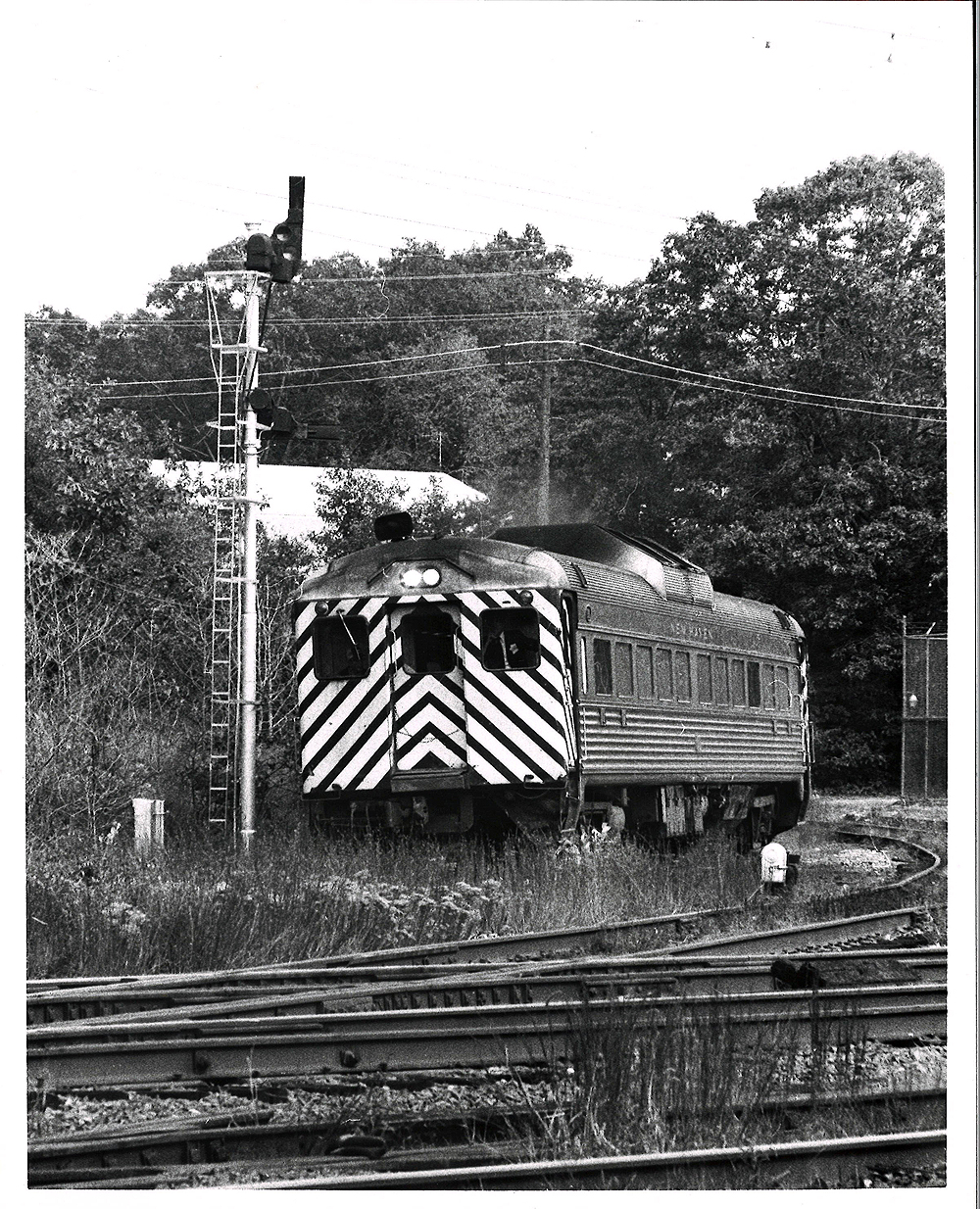

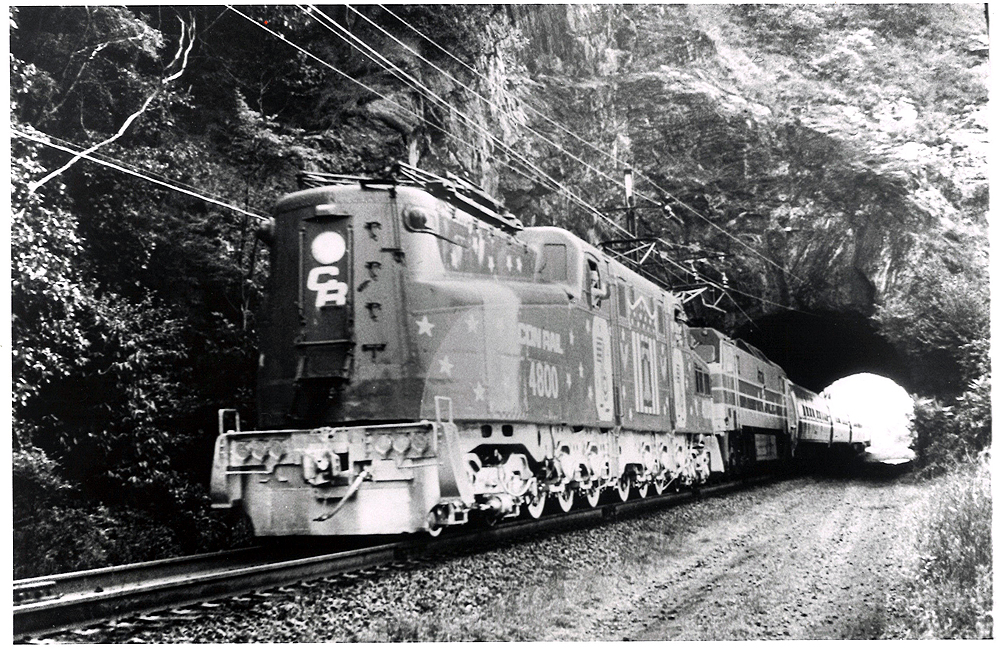





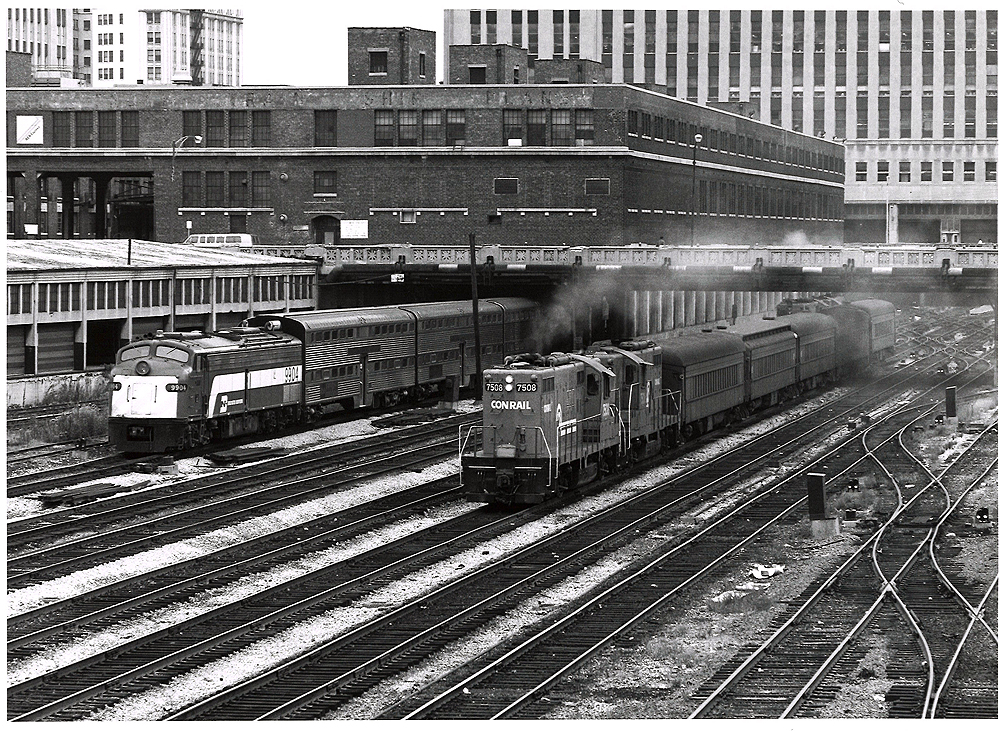

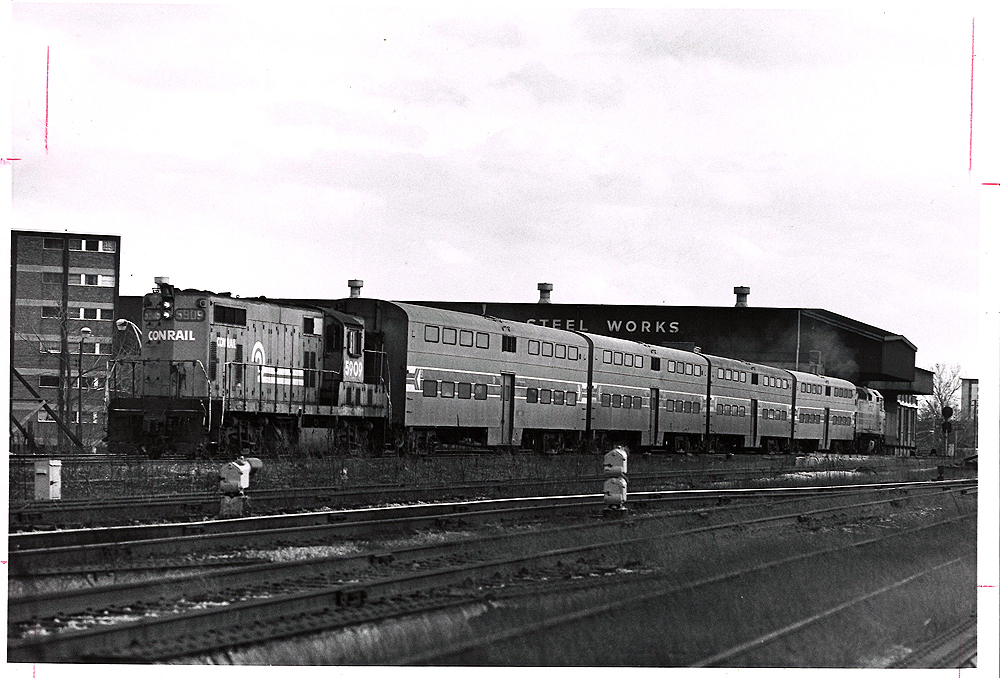













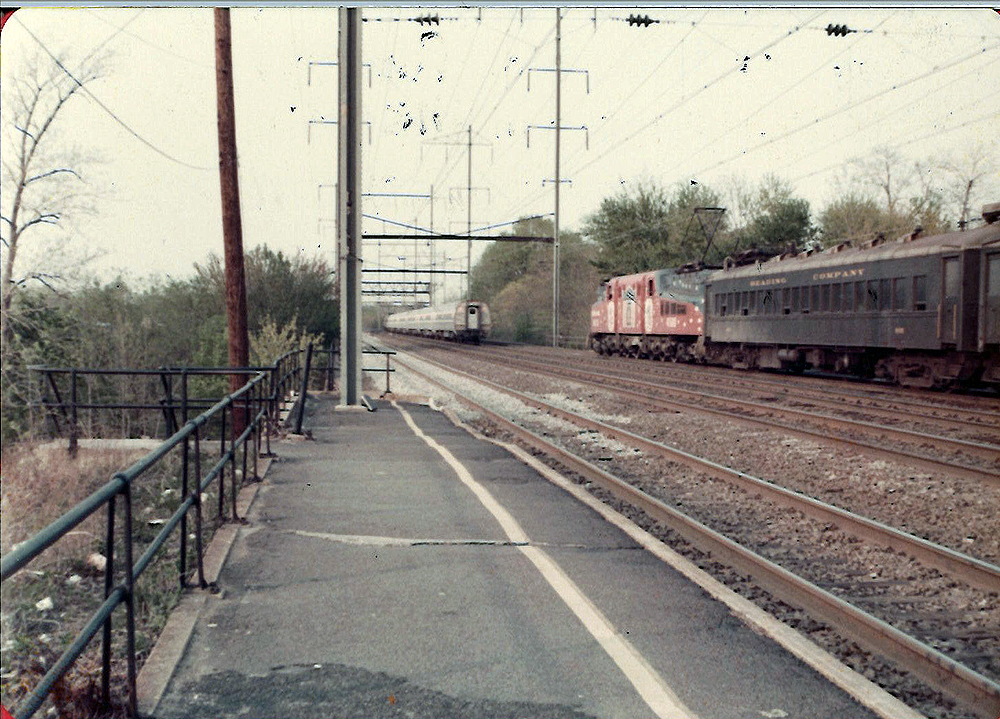


















A final note. In the “Emergency Train” consist are MU cars 800 and 863. 800 is preserved at the RR Museum of PA at East Strasburg while 863 is preserved by Reading Co. T&HS at Hamburg. Both are preserved as MU cars with their pans and bus connectors intact.
Two more thoughts on the ex-RDG electrification. RDG electrified in 1930-1931 and set up the frequency converters for the original fleet (commercial 60 Hz to RR 25 Hz) with 100% redundency to cover maintenance. They acquired 16 more cars in the 1940’s, 17 Budd Silverliner II’s in the 1960’s and 14 GE Silverliner IV’s in the 1970’s without retiring any cars (traffic had increased). They then needed both converters every day. SEPTA has since replaced all the 1930’s frequency conversion equipment (still 25 Hz) but there is a phase break between the RDG side and the PRR side.
The GP30 running backwards was pulling Silverliner IV’s. You will note the pans are up for lighting, heating and A/C.
The two GP10’s are pulling what RDG called the “emergency train,” usually out of service old cars with propulsion difficulties. In snowstorms or those frequent SEPTA transit strikes, they ran on West Trenton trains (less frequent stops) and RDG had used GP35’s then GP39-2’s. CR used GP10’s.
Finally, RDC-3 9166 is ex-B&M. RDG converted it to the larger of two refreshment cars used in its Phila-NY (actually Newark NJ) service. RDG-2 9165 ran on the Crusader and 9166 on the Wall Street. 9166 is now on the RBMN.
4800 going thru a tunnel with an E60 behind is on the Port Road between Perryville MD and Columbia PA and is on a fantrip for the 1976 NRHS Convention. The E60 is to supply HEP to the Amfleet consist.
The Reading MU’s being hauled by 4800 are for the 1977 SEPTA transit strike. These strikes occurred regularly every two years. The MU cars had been retired as self-propelled (considered locomotives) but could still serve as towed passenger cars.
RDG used the same voltage and frequency as PRR and their cars were compatible with PRR’s electrification with the possible exception of high and low wire, and the definite exception of phase breaks. RDG drew its AC power from one source and its power was always in phase but PRR drew its power from multiple sources and there was a possibility one section could be out of phase with the next. A phase break was a short section of wire between power sources that was normally live but when the two ends were out of phase with each other, the “Phase Break” signal was lit and the section was dead.
RDG MU’s had a power line on the roof with bus connectors between cars so a train could use only the front and rear pans and power all the cars. Trailers had no pans and drew power for light and heat from the power line on the roof. A RDG train with front and rear pans up would bridge a phase break with a catastrophic effect on PRR’s power.
The bus connectors were removed when SEPTA converted RDG MU cars to operate on PRR.
Some RDG MU cars had cab signals for the Lansdale trains (RDG Bethlehem Branch) and these were compatible with PRR’s cab signals although RDG’s display was color light and PRR’s position light.
Regarding the picture of GG-1 4800 hauling the ex-Reading EMUs, Torresdale is the easternmost(or northernmost) station within Philadelphia City Limits. This was a strike extra…the Transport Workers Union was on strike against SEPTA’s City Transit Division(the former PTC operations), hence, this extra train(along with a few others. These EMUs lacked the signal equipment needed for NEC service…otherwise, they could have run on their own. The motors were cut out, with a pan or two reaching the wire for light and heating…there were a few chilly mornings during the strike, which ran 44 days